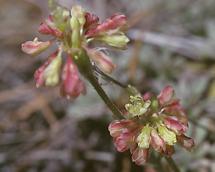Red Mountain buckwheat facts for kids
Quick facts for kids Red Mountain buckwheat |
|
|---|---|
 |
|
| Scientific classification | |
| Genus: |
Eriogonum
|
| Species: |
kelloggii
|
| Synonyms | |
|
Eriogonum caespitosum var. kelloggii (A.Gray) M.E.Jones |
|
The Eriogonum kelloggii is a very special and rare plant. It is often called Red Mountain buckwheat or Kellogg's buckwheat. This plant is found only in one small area of Mendocino County, California. It grows on Red Mountain, which is near a town called Leggett. It's important not to confuse this Red Mountain with another town of the same name in a different county.
This unique plant likes to grow in woodlands. It especially thrives in a type of soil called serpentine soil. This soil is unusual because it has a lot of certain minerals and not much of others. This makes it a tough place for most plants to grow, but Eriogonum kelloggii loves it!
What Does It Look Like?
Eriogonum kelloggii is a type of plant called a perennial herb. This means it lives for more than two years. It grows low to the ground, forming a spreading mat. At its base, it has a woody part called a caudex. This caudex helps the plant store energy and survive.
Its leaves are small, usually less than a centimeter long. They are shaped like oblongs and are covered with soft, silvery hairs. These hairs are especially noticeable on the underside of the leaves. They might help protect the plant from the sun or keep it from losing too much water.
Flowers and How They Grow
The plant's flowers grow on a straight stalk that stands upright. This stalk is called a peduncle. At the top of the peduncle, there is a cluster of many tiny flowers. This cluster is called an inflorescence. The flowers themselves are usually white or light pink.
Protecting This Rare Plant
Because Eriogonum kelloggii is found in such a small area, it is considered an endangered species by the state of California. This means that the state is working to protect it. However, the United States federal government does not currently list it as endangered. Protecting rare plants like this helps keep our planet's amazing variety of life safe for the future.

